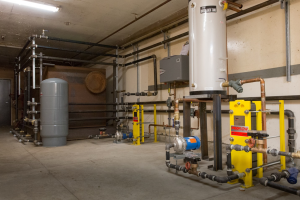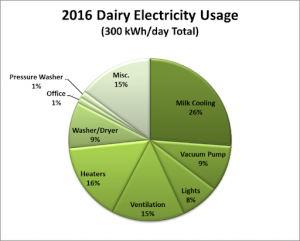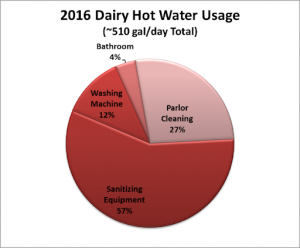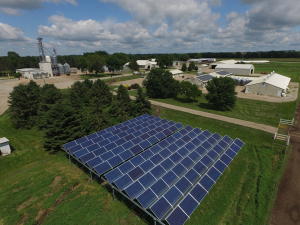Purpose
While animal manure contains nutrients and organic material that are beneficial for crop production, the concentrations of those nutrients are typically too low to allow economically viable transportation of bulk manures over long distances to where crops are sometimes produced. Therefore, dairy manure tends to be applied to soils near where it is generated. Since phosphorous (P) is conserved during manure handling compared to nitrogen, P concentrations in soils where dairy manure is applied tend to exceed crop demands. Due to the implication that P runoff from agricultural operations plays an important role in the eutrophication of streams and other water bodies, farmers are experiencing increasing pressure and regulation to not apply animal manures to fields that are already overloaded with P.
A possible solution to P overloading is to remove some of the P from manure before it is applied. In testing the MAnure PHosphorus EXtraction (MAPHEX) System Church et al. (2016, 2017, 2018), found that by treating liquid dairy manure with a screw press followed by a decanter centrifuge, 38 – 60% of the P could be removed from the manures of a wide variety of farms. A benefit to this approach is that the P removed, is concentrated into a stackable solid (about 72% moisture) that can be more economically transported to distant fields where P may be in deficit. The remaining liquid and course solids, containing greater than 90% of the manure N, can be beneficially used nearer the source without loading those soils with P. A comprehensive farm-scale evaluation of manure nutrient extraction is needed which can be done using the Integrated Farm System Model (IFSM; USDA, 2022). The IFSM has been used to assess other manure handling strategies along with many farm-scale options for crop, animal and feeding management.
What Did We Do?
We evaluated the whole-farm performance, environmental effects, and potential economic benefit of extracting P from dairy manure using a decanter centrifuge (Rotz et al., 2022). A farm in Pennsylvania with distant cropland was simulated with the IFSM to evaluate the feasibility of extracting P to reduce transport requirements on-farm or to produce a concentrated P product for off-farm use. Three production systems were evaluated with and without the use of centrifuge extraction. The first was the current farm with manure collected by flushing, next was the same farm with manure collection by scraping and the last was a modified farm with scraped manure where only forage crops were produced and concentrate feeds were purchased. Collection by scraping greatly reduced the volume of manure handled by the centrifuge thus reducing operating time and electricity use. Reducing the crop land and removing grain production created an imbalance in nutrient utilization with potential accumulation of P in the farm soil. Under this constraint, use of the centrifuge provided a method for removing a portion of the manure P for export from the farm.
Farm simulations estimated all forms of nitrogen, P, and carbon losses. This included erosion of sediment and runoff of sediment-bound and dissolved P across the farm boundaries. Costs for owning and operating the manure handling systems were determined using the economic component in IFSM. All equipment and facilities were amortized over an economic life and the annualized cost was added to other operating costs to get a total. Manure handling costs included fixed and operating (repair and maintenance, fuel, and labor) costs of the rotary screen, screw presses, and centrifuge. Manure hauling was also an important cost in the assessment because the number of trucks required and hauling distance varied among systems. Hauling cost included the amortized initial cost of trucks and annual costs for truck repair and maintenance, fuel, and operator labor.
What Have We Learned?
On a large dairy farm of 2,000 cows and 3,450 acres of land where manure must be transported to distant cropland to obtain uniform distribution, P extraction with a centrifuge provided a better ratio of nitrogen and P contents in manure used on nearby cropland and reduced transport costs for nutrients applied to more distant cropland. Centrifuge extraction was found to be more practical and economical when used with manure scraped from the barn floor than with flushed manure. Use of the centrifuge was not economically justified with the flush system where large volumes of low concentration liquid manure were handled. When barn floors were scraped, the benefit received through reduced manure volume more than offset the increased costs of owning and operating the centrifuge. To avoid long-term accumulation of soil P on the farm with less land (2,000 cows and 2,720 acres) where concentrate feed (27% of total feed) was imported, centrifuge extraction provided a material with a high P concentration that could be exported from the farm for other uses. Extracting the P in excess of crop needs cost about $1.14/lb P. This was generally greater than the price of phosphate fertilizer, but the extract also included other nutrients and micronutrients of value to crops.
A centrifuge provides a useful tool for extracting and concentrating manure P, but the economic benefit to the producer depends upon the value of the full array of nutrients contained, manure handling practices, and the end use of the extracted material. Although marketing this material for its P content alone may not be economical, the material may have other value and the reduction in long-term risk of surface water eutrophication has a less well-defined economic benefit to society.
Future Plans
The IFSM provides a tool for evaluating the performance, environmental impacts and economics of beef cattle and dairy production systems. The addition of the new component for modeling manure nutrient extraction technologies provides a tool for evaluating the whole farm costs and benefits of various technologies being developed or proposed for on-farm use. These can include manure processing based upon dissolved air floatation, evaporation, ultrafiltration, and the full MAPHEX system.
Authors
Alan Rotz, Agricultural Engineer, Agricultural Research Service, USDA
Corresponding author email address
al.rotz@usda.gov
Additional authors
Michael Reiner, Support Scientist, Agricultural Research Service, USDA; Sarah Fishel, Support Scientist, Agricultural Research Service, USDA; Clinton Church, Chemist, Agricultural Research Service, USDA
Additional Information
Church, C. D., Hristov, A., Bryant, R. B., Kleinman, P. J. A., & Fishel, S. K. 2016. A novel treatment system to remove phosphorus from liquid manure. Appl. Eng. Agric. 32: 103 – 112. doi:10.13031/aea.32.10999
Church, C. D., Hristov, A., Bryant, R. B., & Kleinman, P. J. A. 2017. Processes and treatment systems for treating high phosphorus containing fluids. US Patent 10,737958.
Church, C. D., Hristov, A. N., Kleinman, P. J. A., Fishel, S. K., Reiner, M. R., & Bryant, R. B. 2018. Versatility of the MAnure PHosphorus Extraction (MAPHEX) System in removing phosphorus, odor, microbes, and alkalinity from dairy manures: A four-farm case study. Appl. Eng. Agric. 34: 567 – 572. doi: 10.13031/aea12632
Rotz, C.A., Reiner, M., Fishel, S., & Church, C. 2022. Whole farm performance of centrifuge extraction of phosphorus from dairy manure. Appl. Eng. Agric. In press.
USDA-ARS. 2022. The Integrated Farm System Model, version 4.7. University Park, PA: USDA-ARS. Retrieved from https://www.ars.usda.gov/northeast-area/up-pa/pswmru/docs/integrated-farm-system-model
Acknowledgements
This work was supported by the U.S. Department of Agriculture, Agricultural Research Service. USDA is an equal opportunity provider and employer. The authors thank the producer who contributed characteristics of their farm for this assessment.
The authors are solely responsible for the content of these proceedings. The technical information does not necessarily reflect the official position of the sponsoring agencies or institutions represented by planning committee members, and inclusion and distribution herein does not constitute an endorsement of views expressed by the same. Printed materials included herein are not refereed publications. Citations should appear as follows. EXAMPLE: Authors. 2022. Title of presentation. Waste to Worth. Oregon, OH. April 18-22, 2022. URL of this page. Accessed on: today’s date.





